Emma Lazarus was a renowned Jewish-American writer whose most famous poem, 'The New Colossus,' is immortalized on the Statue of Liberty.
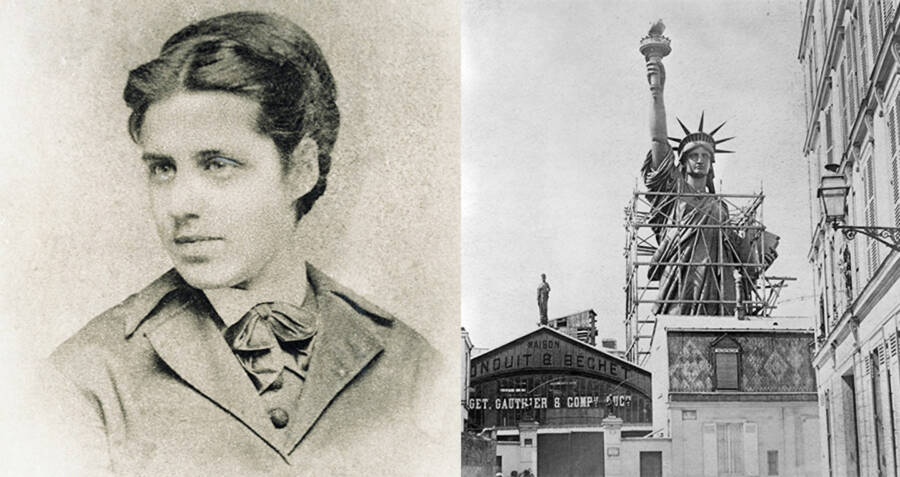
WIkimedia Commons/Getty ImagesEmma Lazarus’ mighty words in ‘The New Colossus’ hang on a plaque on the Statue of Liberty.
Emma Lazarus’ deeply powerful work was very much influenced by her own family background, which consists of a long line of influential figures, and the suffering of the masses of Jewish refugees escaping persecution in Europe. But her most prominent work is arguably the moving sonnet The New Colossus that embodies the soul of American freedom and is inscribed on the Statue of Liberty.
Emma Lazarus: A Natural-Born Writer

Wikimedia CommonsThe talented poet’s work was heavily influenced by her Jewish identity and the refugee crisis during her lifetime.
Emma Lazarus was born 1849 in the vibrant, cosmopolitan neighborhood of Union Square in New York City. The fourth of seven children, Lazarus was a Sephardic Jew.
Her father, a wealthy sugar merchant named Moses Lazarus, could trace his ancestry back to America’s first Jewish settlers who landed in New Amsterdam in 1654 after the Portuguese Inquisition in Brazil. They founded the first American synagogue, Shearith Israel, soon after. Decades later, Lazarus’ maternal great-grandfather, Gershom Mendes Seixas, became the synagogue’s cantor and the first American-born Jewish religious leader ever.
Coming from a privileged family, Lazarus received private tutoring on an array of subjects, from arithmetic to mythology to Italian, but her strongest suit was the written word. Even as a child, Lazarus spent most of her time writing poetry and translating works from German and French. Her parents, particularly her father, encouraged her to pursue her budding passion.
In 1866, when she was only 17 years old, Emma Lazarus published her first book, a 207-age collection her writings and translations. The book, financed by her father, was simply titled Poems and Translations Written Between the Ages of Fourteen and Seventeen. She dedicated it to her dad.
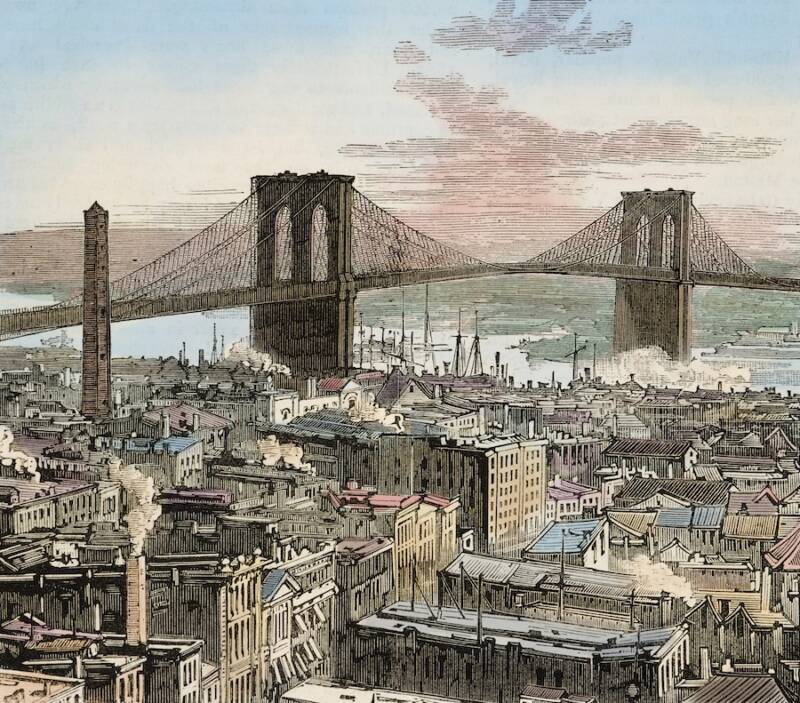
Getty ImagesEmma Lazarus grew up in New York City in the second half of the 19th century.
The next year, Lazarus boldly sent the famed American essayist Ralph Waldo Emerson a copy of her book. The two maintained a steady correspondence, and their relationship as mentor and mentee blossomed over the years. Emerson offered the young writer praise, criticism, and thoughtful notes on her work.
Soon enough, Emma Lazarus’ writings began receiving more public attention. She transitioned from self-publishing to landing poems in popular literary magazines like Lippincott’s and Scribner’s.
In 1871, Lazarus published her second book, Admetus and Other Poems, which she dedicated it to Emerson. The book was widely lauded.
One stellar review from Illustrated London News declared, “Miss Lazarus must be hailed by impartial literary criticism as a poet of rare original power.”
She also wrote plays, novels, and continued to do translation work. Emma Lazarus’ only novel, Alide: An Episode in Goethe’s Life, was praised by the famous Russian author Ivan Turgenev who wrote to her that, “An author who writes as you do…is not far from being himself a master.” By 1882, more than 50 of her poems and translations had appeared in mainstream publications.

Universal History Archive/Getty ImagesRenowned writer Ralph Waldo Emerson recognized young Emma’s talent and became one of her mentors.
Emma Lazarus’ Modern Jewish Identity
Emma Lazarus’ father, Moses, was a successful New York City magnate and moved among the city’s elite circles.
Alongside the Vanderbilts and Astors, he was a co-founder of New York’s elite Knickerbocker Club and worked very hard to help his Jewish family assimilate among the wealthy Christians of America’s upper-class. The family traveled often but spent most of their time away at their summer house in Newport, Rhode Island.
But growing up as a young Jewish girl in the mostly Anglo-Christian circles of New York City’s elite, Emma Lazarus often found herself being the only Jewish person among her friends. Her privileged status did not help shield her from society’s anti-Semitism either. According to historical letters left behind by her famous colleagues, even her best friends would derogatorily refer to her as “the Jewess” behind her back.

Imagno/Getty ImagesThe pogroms in Russia forced Jews to flee Eastern Europe starting in the 1880s. Many of them emigrated to the U.S.
Although her family still observed big Jewish holidays such as Passover and Yom Kippur, Lazarus was several generations removed from the faith’s more orthodox practices. As Lazarus explained, “my religious convictions…and the circumstances of my life have led me somewhat apart from my people.”
But that didn’t stop her from eventually reclaiming her roots.
In 1881, news broke in the London Times of long-simmering conflict that had finally erupted: Jews in Russia and Eastern Europe were being murdered by state-sanctioned pogroms, and 100,000 families were homeless after their homes were pillaged and burned. Hundreds of thousands of Jewish immigrants were coming to the United States to protect themselves from near-certain death.
With this news, Lazarus’ focus shifted. It had been years since she’d even attended synagogue, and her family were more or less outcasts from the Sephardic Jewish community of New York, but Lazarus recognized her connection and bond with the new wave of immigrants. Like her family centuries before, these people — with languages and customs unfamiliar to her — were fleeing religious persecution in Europe.
In 1883, her poem 1492 spoke directly to the religious discrimination that drove her ancestors from Europe and South America:
Thou two-faced year, Mother of Change and Fate,
Didst weep when Spain east forth with flaming sword,
The children of the prophets of the Lord,
Prince, priest, and people, spurned by zealot hate.
Hounded from sea to sea, from state to state,
The West refused them, and the East abhorred.
No anchorage the known world could afford,
Close-locked was every port, barred every gate
On top of her poetry, Lazarus blended art and activism by writing essays criticizing anti-Semitism, xenophobia, and inequality.
She worked with New York’s Hebrew Emigrant Aid Society Employment Bureau, assisting Jewish refugees in learning English and securing employment and housing. Later, she started her own fund for the cause and even traveled to Europe to raise more funds.
Lazarus also focused on anti-Semitism closer to home: In June 1877, German-Jewish banker Joseph Seligman was denied a room by the Grand Union Hotel in Saratoga, New York. The hotel’s owner, another rich man, Judge Henry Hilton (no relation the present-day Hilton chain of hotels), used the excuse of his business competition with Seligman as “reasonable” grounds behind their refusal of Seligman’s patronage, but a news report about the case pointedly stated that “[hotels] desire a different class of customers from that which the Jewish people bring, and therefore they decline as a rule to receive the latter.”
Anti-Semitism was alive and well in the United States, and Lazarus used the power of her pen to fight it.
Her series of pieces in the mainstream publication Century, edited by her friend and fellow poet Richard Gilder, was among the first by the prominent literati to eloquently put into words criticism and resistance against anti-Semitism of all kinds.

FPG/Getty ImagesMuch of Emma Lazarus’ writing spoke directly to the discrimination suffered by Jews in the U.S. and around the world.
She wrote a series of articles titled Epistle to the Hebrews which appeared in the popular journal, The American Hebrew, reminding readers that “until we are all free, we are none of us free,” words that remain some of her most recognized to date.
Excerpts from her 1882 book Songs of a Semite: The Dance to Death and Other Poems, regarded as some of the best work of her career, contained Jewish-themed poems and a five-part play that highlighted the discrimination against German Jews during the plague of the 1300s.
The New York Times wrote that the collection “enlists the sympathy of anyone who believes that…in the case of a race which has suffered, and in some centuries yet suffers, great injustice, attention drawn to its achievements in literature will encourage such respect and admiration as it deserves.”
The New Colossus
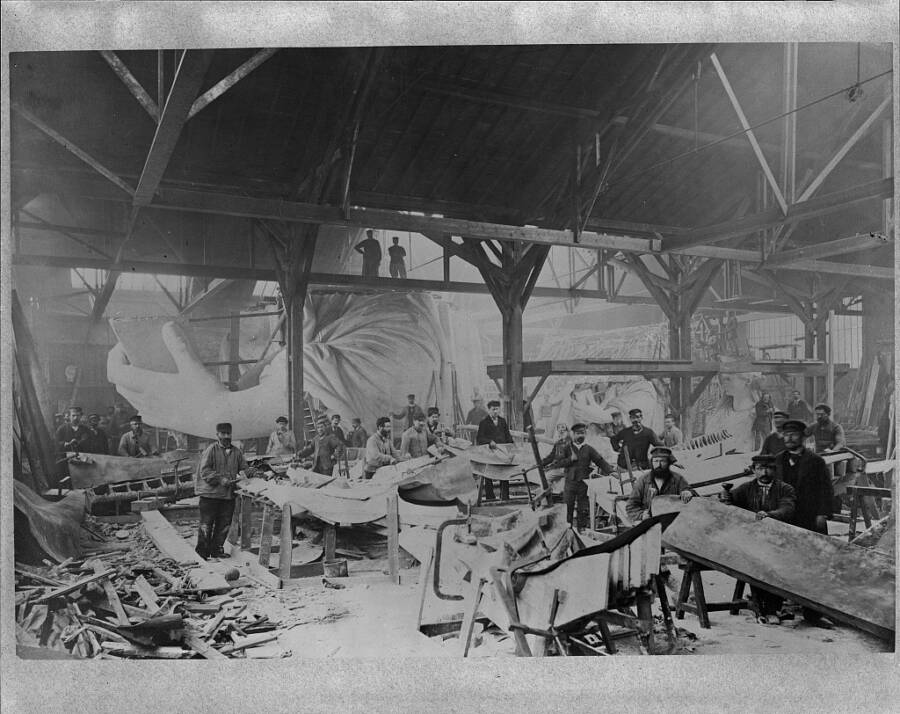
Workmen constructing the Statue of Liberty in Frédéric Auguste Bartholdi’s Parisian warehouse.
Despite her lifetime reputation as an outspoken advocate for the plight of Jews in America — and to an extent across the world — Emma Lazarus will first and foremost be remembered for her powerful sonnet etched at the base of the Statue of Liberty.
In the late 1870s, the French gifted the Statue of Liberty to the U.S. as a celebration of freedom and the abolition of slavery, an endeavor that the Americans had theoretically achieved and the French had yet to reach in all of its territories.
Some say the statue, designed by Frédéric Auguste Bartholdi, was part of efforts by the pro-abolitionist and pro-democracy movements in France to garner support for the cause.
Nevertheless, the U.S. government gladly accepted the gift. But it came with a catch: that costs for the pricey statue would be covered by both countries. France would cover the costs of constructing the statue and transporting it to the States, while the U.S. needed only to worry about erecting it on its pedestal.
Fundraising began in 1882, and the following year the statue’s supporters held an art auction to raise funds.
By this Emma Lazarus had solidified her reputation as among America’s most celebrated and prolific writers. Playwright Constance Cary Harrison, who was working to gather artists to join the exhibit, approached Lazarus to contribute a poem for the auction.
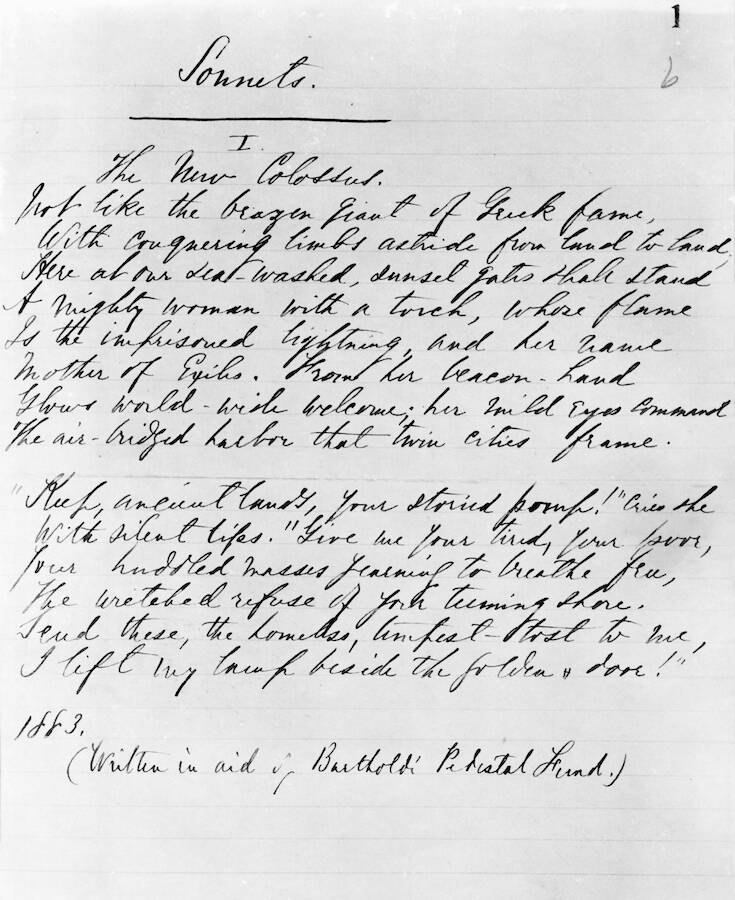
Getty ImagesThe original manuscript of Emma Lazarus’, The New Colossus.
Surprisingly, the socially-minded poet was not immediately drawn to the idea, and resisted the proposal at first.
“I don’t write on command,” Lazarus said. But knowing Lazarus’ work with refugees, Harrison persuaded her by appealing to her social conscience.
“Think of that Goddess standing on her pedestal down yonder in the bay, and holding her torch out to those Russian refugees of yours you are so fond of visiting at Ward’s Island,” Harrison recalled saying. “The shaft sped home — her dark eyes deepened — her cheek flushed…she said not a word more, then.”
Lazarus returned to Harrison two days later with a completed poem. The sonnet was titled The New Colossus, a not-so-subtle rebuke against the ancient Greek Colossus of Rhodes, a macho male statue erected in the 3rd century B.C.
Her poem championed Lady Liberty as the new American colossus, a beacon of maternal strength and equality. It remains one of the most recognized poems to date:
Not like the brazen giant of Greek fame,
With conquering limbs astride from land to land;
Here at our sea-washed, sunset gates shall stand
A mighty woman with a torch, whose flame
Is the imprisoned lightning, and her name
Mother of Exiles.From her beacon-hand
Glows world-wide welcome; her mild eyes command
The air-bridged harbor that twin cities frame.“Keep, ancient lands, your storied pomp!” cries she
With silent lips. “Give me your tired, your poor,
Your huddled masses yearning to breathe free,
The wretched refuse of your teeming shore.
Send these, the homeless, tempest-tost to me,
I lift my lamp beside the golden door!”
The powerful sonnet made its debut at the statue’s fundraising exhibit in 1883 and, according to Lazarus biographer Bette Roth Young, it was “the only entry read at the gala opening.”
As noted by the Poetry Foundation, “the poem is pluralistic in its roots. It is an Italian sonnet composed by a Jewish-American woman, contrasting an ancient Greek statue with a statue built in modern France.”

Wikimedia CommonsThe Statue of Liberty was delivered to the U.S. in pieces and had to be reassembled.
The Statue of Liberty fundraising campaign was a success and raised $100,000 (or nearly $2 million today) from donations of a dollar or less within the span of months. Following the poem’s premiere, poet James Russell Lowell wrote praisingly to Lazarus, “Your sonnet gives its subject a raison d’etre.”
Ironically, The New Colossus was quickly forgotten after fundraising efforts were finished. Nobody talked of the moving literature again, not even after Emma Lazarus’ untimely death from an illness many suspect was Hodgkin’s lymphoma on Nov. 19, 1887 — five years after writing the poem. She was 38.
It wasn’t until 1901 when Lazarus’ close friend Georgina Schuyler rediscovered the poem that it was resurrected. In honor of the late poet, Schuyler organized efforts to memorialize the piece and, two years later, The New Colossus was embedded on a plaque at the base of the Statue of Liberty.
The Legacy Of Lazarus’ Poem
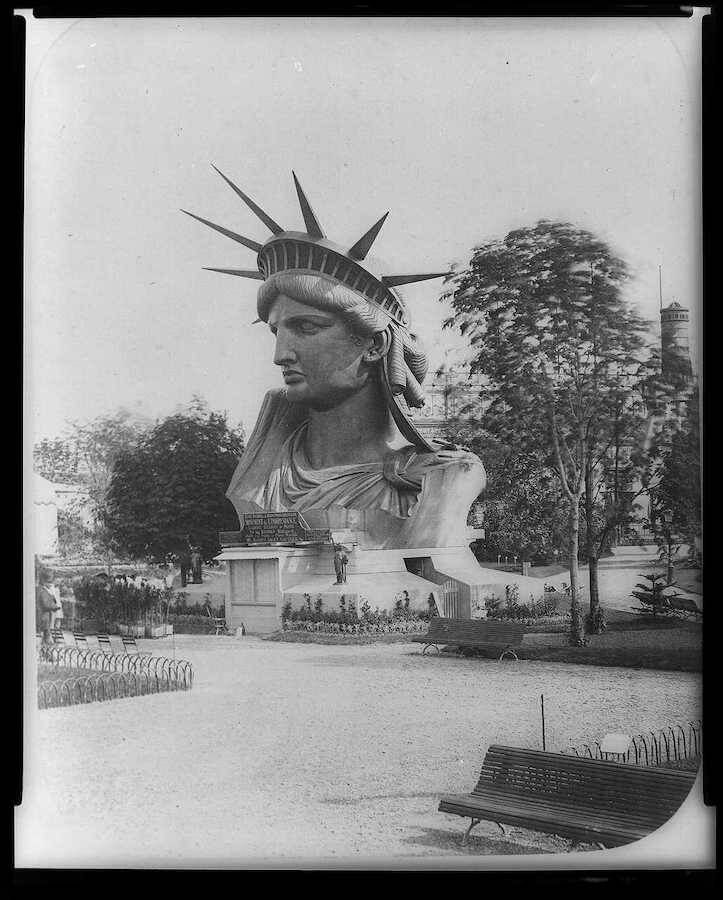
Library of CongressPart of the Liberty Statue on display in a Parisian park as part of a promotional campaign for its construction.
Although Emma Lazarus’ The New Colossus is deeply intertwined with American history and identity, and with the mythos of the Statue of Liberty, it wasn’t originally supposed to be part of the statue.
By all accounts, Emma Lazarus had never even seen the Statue of Liberty when she wrote the piece, nor did she care for its intended meaning by the French — a larger-than-life symbol of Republicanism and the end of slavery.
Immigration policy has long been a dividing issue in the U.S. It was true during Emma Lazarus’ lifetime, and it still rings true today. The contentious issue has even sparked renewed interest and debate about whether Lazarus’ immortal words etched on America’s Lady Liberty remain in line with modern American values.
In August 2019, Ken Cuccinelli, the acting director of the United States Citizenship and Immigration Services, which oversees the country’s immigration system, put his own twist on Emma Lazarus’ reverberating words.
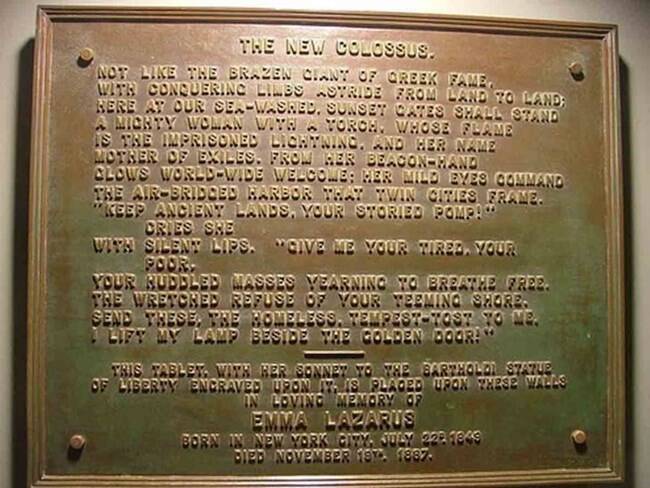
National Park ServiceEmma Lazarus’ poem has been affixed to the Statue of Liberty’s pedestal since 1903.
According to Cuccinelli, the poem’s most famous line, “Give me your tired, your poor, your huddled masses yearning to breathe free,” was meant to apply only to those “who can stand on their own two feet and who will not become a public charge.”
The government official’s stunning comments came following President Donald Trump’s updated public charge policy, banning immigrants who would require government aid from entering the country legally.
But no matter how Emma Lazarus’ striking words ended up on the Statue of Liberty, or how partisan entities claim those words ought to be interpreted, the Statue of Liberty’s promise of protection and equality, and Emma Lazarus’ resounding words, are an inalienable part of America’s history.
Next, meet Irena Sendler, the woman who saved 2,500 Jewish children during the Holocaust. Then, discover what Jewish life looked like in Europe before the Holocaust.





